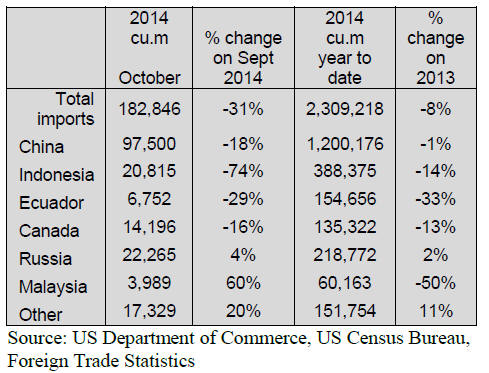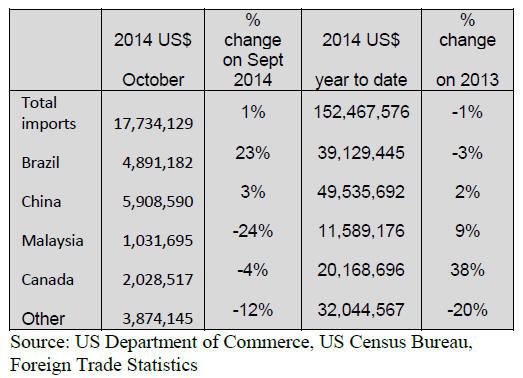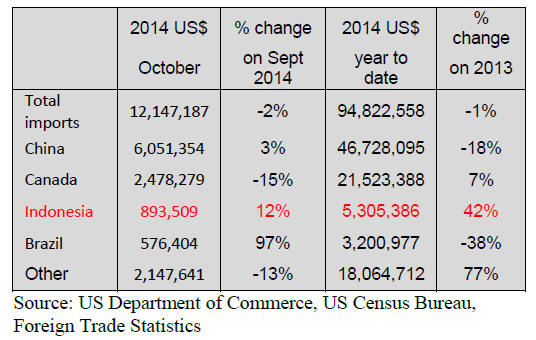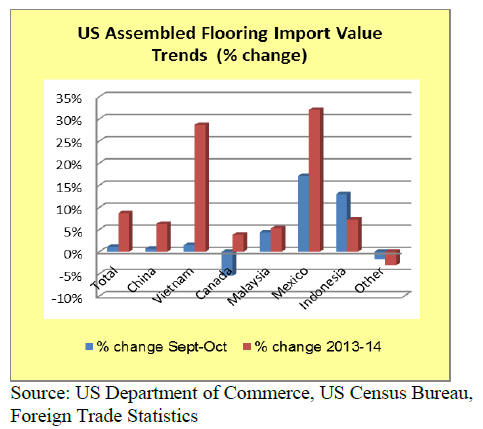|
Report from
North America
Steep decline in plywood imports in October
US imports of hardwood plywood fell by almost one third
in October. Total imports were 182,846 cu.m. Year-to-date
imports were 1% lower than at the same time last year.

All major suppliers were affected by the decline in
imports, but the strongest decrease was in imports from
Indonesia. Indonesian plywood shipments to the US were
20,815 cu.m., down 74% from September. Year-to-date
imports from Indonesia were 9% lower than in 2013.
Hardwood plywood imports from China decreased by 18%
in October to 97,500 cu.m. Year-to-date imports remain
7% higher than in 2013. Imports from Canada and
Ecuador fell by 16% and 29%, respectively.
Russia‟s hardwood plywood shipments to the US
increased to22,265 cu.m. Year-to-date imports from
Russia were 12% higher than in October 2013.
Moulding imports from Brazil up 23%
There was little change in hardwood moulding imports in
October. Total imports were worth US$17.6 million. Yearto-
date imports were 10% higher than in October 2013.
All major suppliers shipped more moulding to the US
compared to October 2013.
Hardwood moulding imports from China increased by 3%
to US$5.9 million in October. Brazil‟s shipments were
worth US$4.9 million, up 23% from September.
Imports from Malaysia fell by 24% in October from the
previous month, but year-to-date imports were 19% higher
than in October 2013.

Significant growth in assembled panel flooring imports
from Indonesia
Hardwood flooring imports decreased by 13% to US$3.4
million in October, but on a year-to-date basis imports
remain higher than at the same time last year. Assembled
flooring panel imports declined slightly from September to
US$12.1 million (+11% year-to-date).
The largest fall in hardwood flooring imports was from
Malaysia. Imports fell by 18% to US$928,701. Hardwood
flooring imports from Indonesia declined by 3% to
US$606,766.

Assembled flooring panel imports from China were
US$6.1 million in October, up from the previous month
but lower than in 2013. Imports from Canada and
Indonesia increased in October. Indonesia‟s monthly
shipment value was nearly US$1 million, and year-to-date
imports from Indonesia were 65% higher than in October
2013.

Strong growth in furniture imports from Vietnam and
Mexico
Wooden furniture imports grew by 1% in October and
were worth US$1.28 billion. Year-to-date imports were
9% higher than at the same time in 2013.
Imports from most supplier countries increased in
October, with the exception of Canada. Year-to-date
imports from all major suppliers were higher than in
October 2013. China‟s imports share was 47.5% in
October. Vietnam‟s import share was 18%.
Furniture imports from China were worth US$610 million,
up 1% from September. Vietnam‟s wooden furniture
shipments increased also by 1% to US$232 million. Yearto-
date imports from Vietnam were almost one third
higher than in September last year.
The largest growth in wooden furniture imports compared
to last year was from Mexico. October imports were worth
US$62.3 million. Year-to-date imports from Mexico were
one third higher than in October 2013.
October furniture retail sales down
Furniture retail sales declined by 3% in October, according
to US Census data. However, furniture sales were 1%
higher than in October 2013.
GDP growth revised up, unemployment unchanged
The Department of Commerce has revised upwards its
estimate of GDP growth in the third quarter of 2014, from
previously 3.5% to 3.9%. Growth remains lower than in
the second quarter, but the US economy is now healthier
than most other large economies.
The unemployment rate was unchanged in November at
5.8%. Unemployment decreased by 1.2 percentage points
in the last 12 months, according to the US Department of
Labor. In November, the number of jobs in the
manufacturing sector grew by 20,000. A total of 171,000
manufacturing jobs were added since November 2013.
Growth in domestic furniture production in November
Furniture production was among the fastest growing
manufacturing industries in November. Wood product
manufacturing companies reported no significant change
in production since September.
Both furniture and wood product manufacturers were
generally satisfied with market demand.
US consumer positive about economy
Consumer confidence in the US economy rose in
November to the highest level since July 2007, according
to the Thomson Reuters/University of Michigan consumer
sentiment index.
Consumers said they were more likely to buy larger
household items. Even younger consumers and long
income households expect to buy more in the coming
months. Consumers anticipate lower unemployment and
higher incomes in the year ahead.
US South home builders most confident in market
Builders‟ confidence in the market for newly built singlefamily
homes declined in October, but the home builders‟
outlook was more positive in November.
Growing consumer confidence, higher employment and
low interest rates support home construction and sales.
Builders reported more home buyers and signed contracts
in November.
Home builders in the US South were most positive about
market conditions. Builders in the Northeast were the least
confident.
Housing starts over 1 million in October
The housing market was strong in October with over 1
million starts at a seasonally adjusted annual rate. Singlefamily
housing starts grew by 8% from the previous
month. Single-family starts accounted for almost 70%, the
highest share this year to date.
Multi-family construction declined in October. However,
construction of apartment buildings appears to remain
higher than in the past because of high demand for rental
housing.
The growth in residential construction was almost entirely
in the US South.
The number of building permits increased by 5% to 1.08
million at a seasonally adjusted annual rate.

Sales of existing homes increased by 1.5% in October,
according to the National Association of Realtors. Sales
activity was the highest so far in 2014. Homes sales were
also higher than at the same time last year.
Home prices also increased in October. The inventory of
homes available for sale is higher than last fall and winter,
which may prevent the strong price increases seen last
year.
Broad recovery in non-residential construction
expected for 2015
Private non-residential construction spending was
unchanged from the previous month (at seasonally
adjusted annual rate). Public construction grew by 3% in
October.
The strongest growth was in public commercial
construction (+11%) and public office construction (+8%).
Architecture firms remained positive about business
conditions in October. The American Institute of
Architects expects a broad recovery in non-residential
construction.
US-Canada Softwood Lumber Agreement expires in
2015
The agreement for Canadian exports of softwood
sawnwood to the US will expire in October 2015. The
current trade agreement from 2006 was a solution to US
industry claims that Canadian forest policies subsidize
sawnwood production. The agreement specifies higher
duties on Canadian exports when softwood sawnwood
prices are low.
The Canadian industry fears uncertainty if the trade
agreement is not renewed. The US has agreed to not
launch legal battles for twelve months after the current
agreement expires in 2015.
According to reports by the newspaper Vancouver Sun,
the Canadian industry would like to see the current
agreement renewed. US sawmills represented by the US
Lumber Coalition are reported to oppose a renewal.
If Canadian sawmills will have to pay new higher duties
on exports to the US, it is likely to affect trade flows to
other markets including China.
Between 2001 and the signing of the 2006 agreement,
Canadian producers paid CUS$5 billion in export duties to
the US. Most of the duties were returned when the 2006
agreement was signed.
Since 2006 several change have occurred in the industry.
China has become the second largest export market for
Canadian sawnwood producers. The Canadian market
share in the US has fallen from 34% in 2006 to 29% in
2013, partly due to lower US demand.
Forest resources in British Columbia are significantly
lower now because most trees killed by the mountain pine
beetle infestation have been processed.
However, the falling value of the Canadian dollar due to
lower oil prices is a threat to US producers. When the
agreement expires, Canadian sawnwood will likely be
cheaper for US buyers than any time since 2006.
The largest Canadian producers (Canfor, West Fraser
Timber and Interfor) have bought sawmills in the US in
recent years. This mitigates their risk if a new trade
dispute starts after the current trade agreement expires.
* The market information above has been generously provided by the
Chinese Forest Products Index Mechanism (FPI)
|